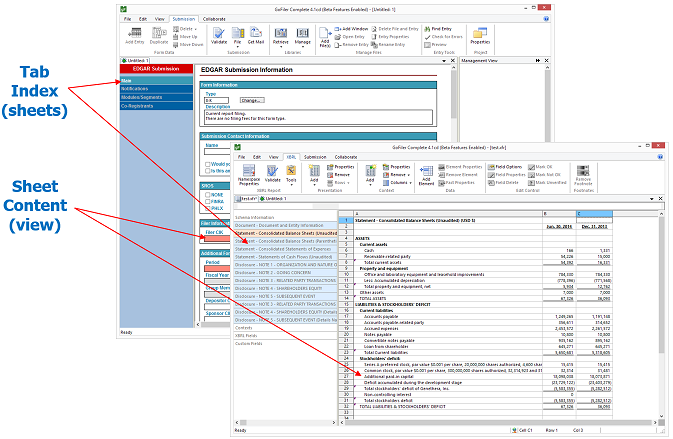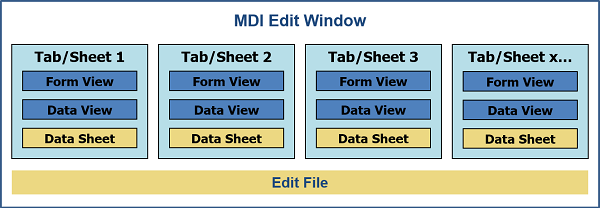  |
GoFiler Legato Script Reference
Legato v 1.6e Application v 6.3a
|
| Table of Contents | < < Previous | Next >> |
Chapter Eighteen — DataView Integration
Data View is a powerful spreadsheet style window that allows multiple sheets and views to be incorporated into single edit object for managing forms, spreadsheets, project data, and a variety of information. Data View is employed in all EDGAR Form Views, XML forms and projects, and XBRL.
The following is an example of a table Data View window:

In this case, the first MDI window contains four visible tabs (there can be hidden tabs) and multiple sheets with only the selected sheet visible. It is not necessary for a sheet to be visible to access its contents. The second example contains multiple tabs for XBRL presentations.
This section discusses how to interface to Data View and parts of its components to read, write and generally control the contents.
It is important to note that changing the contents or properties of certain cells can result in unpredictable or undesired behavior, including the loss or corruption of data. Modifying low-level contents requires a comprehensive understanding of the form structure and how it is used by the application. Moreover, any scripts that directly rely on the templates and their respective named areas are subject to become outdated when new releases of the software are installed. By using “named” items (discussed later), a script can generally be isolated from subtle changes in the templates.
A window employing Data View will have three basic layers, each inside of a tab:

This section discusses the Form View and Data View layers while the Data Sheet layer is discussed in the Data Functions chapter. Each sheet contains these components, which are held together by a Mapped Text Object and an MDI Edit Window Container. In most applications, the native Data View (which operates in a manner similar to a spreadsheet) is not directly accessible by the user.
The Form View is a high-level abstraction layer and in many cases is loaded as a Data View Template and managed by a specific and separate module (as in the above example). For example, the EDGAR Submission View module is separate and distinct from the XBRL View module but they both employ the same underlying Data View and Data Sheet Objects. Operation of the cursor and availability of user editing functions may be significantly curtailed depending on the specific view.
It is also worth noting in the example above that the project window within the Management View is a Data View. Further, Data View can be employed as a list box style dialog control.
Cells are generally addressed by row and column position as integers. This is referred to as a cell index. At the higher level of a form or Data View, they can also be referenced by sheet positions as letter columns and numeric rows (for example, ‘0:0’ is the same as ‘A1’). This referenced mode, similar to typical spreadsheet applications, is known as a cell address. In this case the first row is 1 not 0 (as in a zero-inclusive index). In some cases, cell addresses can also contain the sheet name.
Outside of various Data View functions, cell addresses and index references can be converted using the CellAddressGetColumn, CellAddressGetRow, CellAddressToIndex, and CellIndexToAddress functions.
Cells can also be addressed by name.
This chapter is broken down as follows:
Data View Objects— Functions to access various Data View components.
Sheet Level Access— Local functions are available to control the sheet. The underlying Data Sheet objects are also accessible. See Section 8.6 Data Sheet for more information.
Row Functions— Provides access to row level data and edit functionality.
Column Functions— Provides access to column level data and edit functionality.
Cell Position Functions— Provides access to cell level data and edit functionality.
Cell Access Functions — Provides access to cell level data and edit functionality.
Forms View Functions — High-level form functions available on some views that inherit Data View.
Events — Events for both Data View and Forms View.
File/View Level Functions:
DataViewOpenFile — Opens a file in a data view mode with optional file type.
| Table of Contents | < < Previous | Next >> |
© 2012-2025 Novaworks, LLC. All rights reserved worldwide. Unauthorized use, duplication or transmission is prohibited by law. Portions of the software are protected by US Patents 10,095,672, 10,706,221 and 11,210,456. Novaworks, GoFiler™ and Legato™ are registered trademarks of Novaworks, LLC. EDGAR® is a federally registered trademark of the U.S. Securities and Exchange Commission. Novaworks is not affiliated with or approved by the U.S. Securities and Exchange Commission. All other trademarks are the property of their respective owners. Use of the features specified in this language are subject to terms, conditions and limitations of the Software License Agreement.